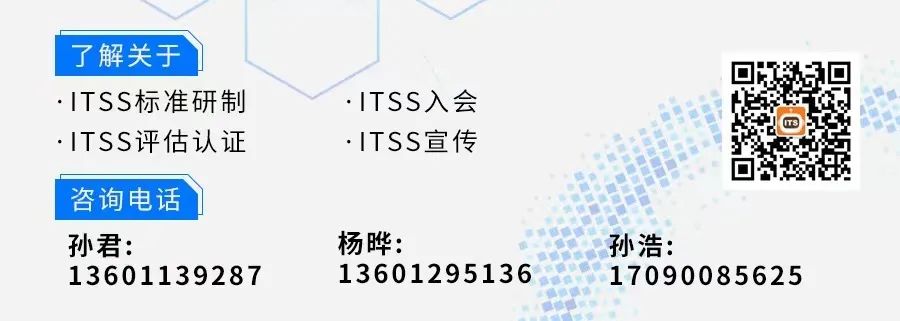
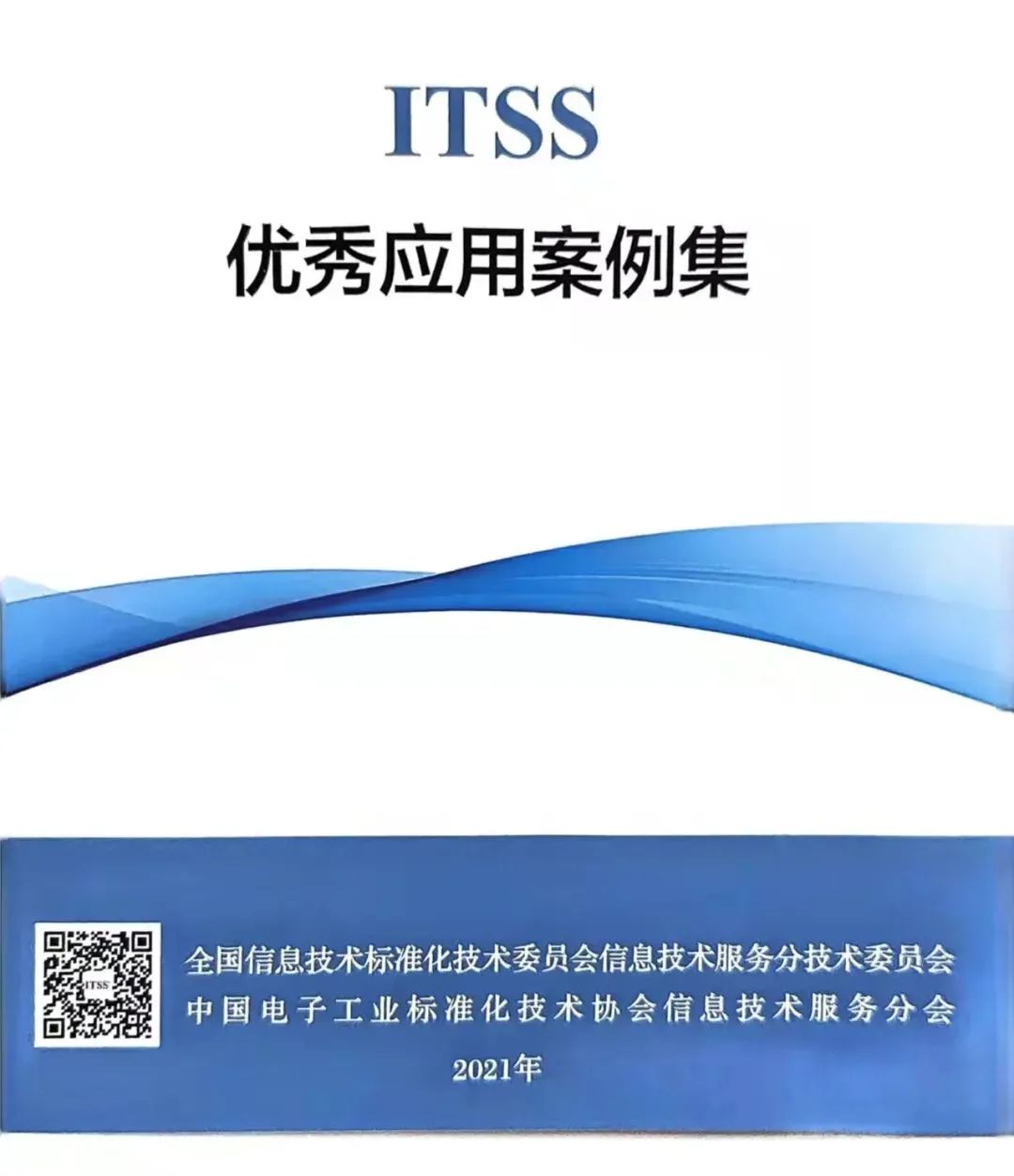
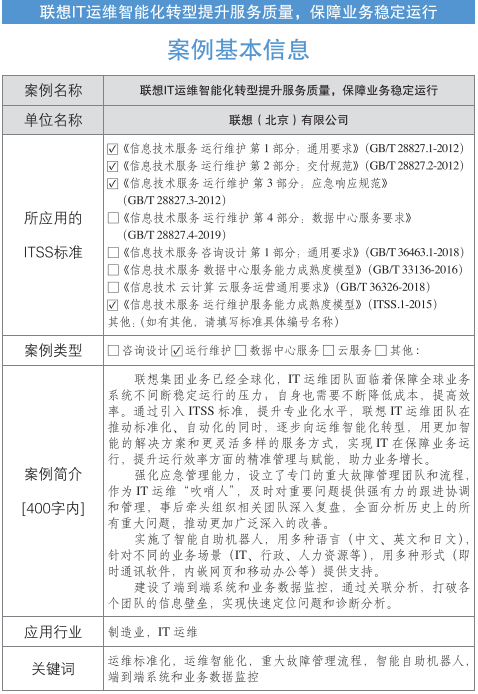
Case Background
01
Implementation Background
Lenovo Group is a Fortune 500 company founded in China, operating in 180 markets worldwide. As a leading manufacturer of smart devices, Lenovo ranks 15th on Gartner’s top global supply chain list. Each year, Lenovo provides billions of smart terminal devices to users worldwide, including computers, tablets, and smartphones.
Lenovo has a large global workforce distributed across 170 countries and regions, spanning all time zones. Daily, over 70,000 documents are shared, more than 600,000 emails are sent, and over 160,000 conversations or multi-party online meetings occur. These are all supported by Lenovo’s IT operations team. Additionally, the team manages over 25,000 IT devices, more than 4,500 physical servers, and over 400 business application systems.
The Lenovo IT operations team faces two main challenges: on one hand, the business has become globalized, with high complexity in business application systems and a strong dependency on IT, making it crucial to provide 24/7 support and maintain system stability. On the other hand, the IT operations team is also required to continuously reduce costs, improve efficiency, and demonstrate professionalism and value. By introducing the ITSS standard, the team has continuously promoted the collaborative improvement of personnel, processes, resources, and technology, enhancing operational maturity and achieving precise management and empowerment of IT in ensuring business operations and improving operational efficiency, thus supporting business growth.
Implementation Goals
With Lenovo’s globalization, the development of IT operations has gone through three stages, currently in the “Intelligent” stage.
“Integration” Stage (1998-2004): With the establishment of Lenovo, an information system was gradually built, especially the ERP system. During this stage, Lenovo’s operations were closely tied to hardware such as desktops, servers, and networks, initially establishing unified IT service management. “Globalization” Stage (2005-2016): Since Lenovo acquired IBM’s ThinkPad business in 2005, the IT operations team has focused on building a standardized operational service system. During this period, the ITSS standard was introduced, continuously promoting the collaborative improvement of personnel, processes, resources, and technology, defining standard IT operations processes and service catalogs around core business systems, and achieving significant technological advancements such as cloudification of infrastructure resources.
Intelligent Operations Stage (2017-Present): In 2017, the Lenovo IT operations team proposed a strategy for intelligent transformation, implementing quantitative management of operational service capabilities, using smarter solutions and more flexible service methods to ensure business operations. In the second half of 2019, the first level of ITSS standard maturity was introduced, and in 2020, results were seen. By establishing and applying models, integrating them with service business, and continuously improving, the team has driven ongoing enhancement and innovation in operations, developing applications to support both agile and stable business development. A quantitative indicator evaluation system has been established in areas such as capability management, delivery management, emergency management, personnel management, resource management, and technology management, supporting the company’s strategic goals through the development of multi-cloud architecture and self-service.
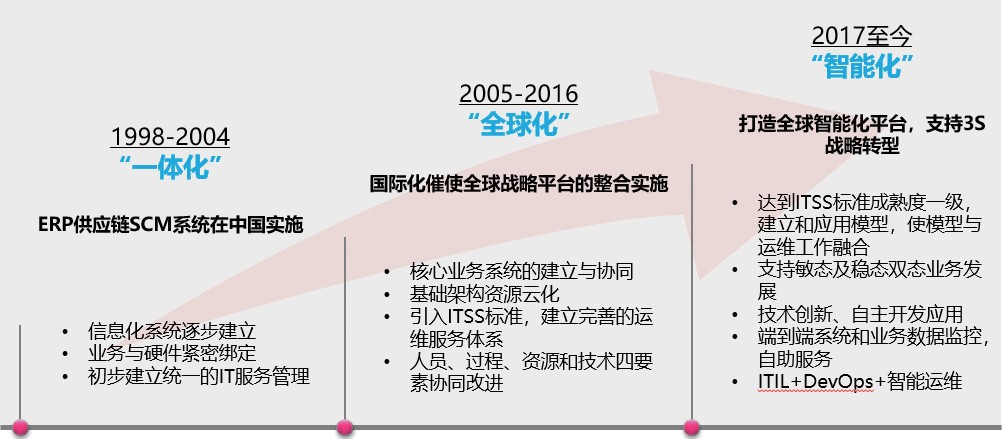
Application Process
02
Annual Work Summary Implementation Plan
Based on its development needs, the Lenovo IT operations team proposed a strategy for intelligent transformation in 2017. By introducing the ITSS standard, a series of intelligent products and solutions were developed and innovated, which are not only applied in the IT field but also promoted to business teams, assisting in achieving digital operations.
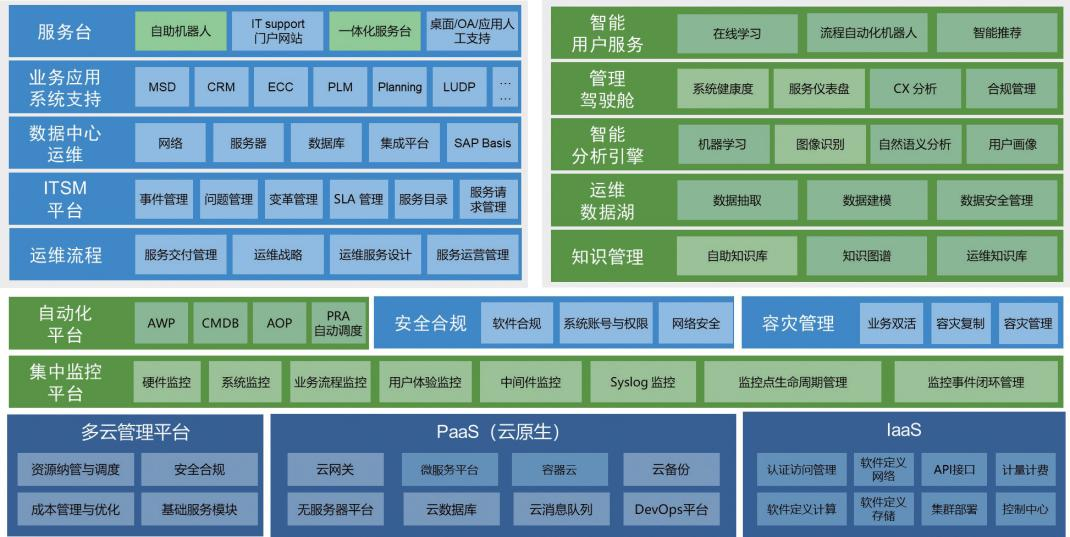
Implementation Process
Guided by the ITSS standard, the Lenovo IT operations team promotes intelligent transformation around four elements: personnel, resources, processes, and technology.
In terms of personnel, the Lenovo IT operations team has established unified processes for incidents, monitoring, problems, configurations, changes, and releases based on the ITSS standard, clarifying responsibilities. For major incident management, emergency management capabilities have been strengthened, with a dedicated Major Incident Management (MIM) team and process established to tackle critical issues, acting as the “whistleblower” for IT operations, providing strong follow-up coordination and management for important problems, and serving as the communication window for significant IT issues, providing real-time updates on processes. After incidents, the team leads relevant teams in in-depth reviews, formulates improvement measures to prevent similar issues from recurring, and promotes continuous optimization between IT and business teams. A comprehensive analysis of all major historical issues has been conducted, proposing and promoting broader and deeper improvement measures, strengthening the sense of responsibility within the IT operations team, enhancing team combat effectiveness, demonstrating the value and capabilities of IT operations to business teams, and laying the organizational foundation for intelligent transformation.
In terms of resources, in addition to implementing a CMDB to store hardware and software data of the IT environment, the operations team has also implemented an operations data lake, integrating metrics, logs, and operational documents collected from the monitoring platform, as well as IT environment data from the CMDB, ensuring high-quality data that supports IT user profiling, intelligent knowledge recommendations, and intelligent analysis applications.
In terms of processes, based on intelligent operations, a real-time management dashboard for incidents, monitoring, problems, configurations, changes, and releases has been implemented, enabling SLA compliance tracking; a 360-degree system health check for core applications has been achieved, allowing real-time monitoring of application health and proactive fault response; and customer experience analysis has been implemented, addressing user feedback and winning praise from key users in business departments.
Several intelligent initiatives have been implemented in the technology aspect, including:
Intelligent Self-Service Robot
With the growth of the business, Lenovo’s employee count has more than doubled in five years, with the number of service requests increasing from 250,000 to 500,000. This massive growth has posed significant challenges for the operations team.
As the pressure on the operations service desk has gradually increased, we have enhanced engineer capabilities, optimized document management processes, strengthened service quality management, and consolidated standard IT service knowledge based on the guidance of the “Information Technology Service Operation and Maintenance Part 1: General Requirements” (GB/T 28827.1-2012). On this basis, the operations team developed an intelligent self-service robot product that accurately understands user intent through a natural language processing engine, combining it with a knowledge graph to provide precise answers to users, achieving “ease of search”; the intelligent self-service is integrated with multiple business systems, allowing users to complete queries, requests, approvals, and modifications with a single click through an optimized interface and simplified forms, achieving “ease of operation”.
After receiving unanimous recognition and praise from users, we adopted an open approach to apply this technology to more internal service scenarios, providing diverse support in multiple languages (Chinese, English, and Japanese) for different business scenarios (IT, administration, human resources, etc.):
Instant Messaging Software: Skype is an essential instant messaging software for every Lenovo employee. The robot service is deployed to Skype accounts, allowing employees to access self-service in their preferred manner.
Embedded Web Pages: The embedded robot can be deployed on any webpage and can customize independent Q&A content. When users encounter issues on a web-based system, the robot answers questions directly on the page, providing solutions.
Mobile Office: At Lenovo, the mobile office software “LeLiao” provides employees with a handy toolbox for chatting, requesting leave, approvals, and queries. We developed a mobile robot integrated with the LeLiao app, allowing employees to ask questions and receive answers just like on the PC.
By implementing the intelligent self-service robot, the Net Promoter Score (NPS) increased from 50 to 72, with annual response volume exceeding 300,000, saving approximately 25% of preparation time for IT service desk agents.
End-to-End System and Business Data Monitoring
As Lenovo’s business expands, operations face significant challenges, with a substantial increase in the number of hardware and software and growing application complexity. Due to the long business chain at Lenovo, a single fault often involves multiple systems, and the IT operations team can no longer monitor and handle faults using traditional tools, processes, and skills. Therefore, the operations team has developed end-to-end system and business data monitoring capabilities, breaking down information silos between teams through correlation analysis, enabling rapid problem identification and diagnostic analysis.
End-to-end system and business data monitoring needs to cover three layers: infrastructure, application systems, and business. The technical team drives monitoring metrics at the infrastructure layer, making them more universal and standardized; application-level monitoring is customized based on different business needs and technical architectures; business-level monitoring is usually driven by business processes or scenarios, highly customized and often cross-application. Through 24/7 real-time monitoring without blind spots, the stability of application systems and business execution is ensured.
By implementing end-to-end system and business data monitoring, we utilize big data technology, machine learning algorithms, and other methods to achieve intelligent early warning of business processes. For example, in monitoring Lenovo’s global supply chain planning system, which supports global supply chain operations, the business heavily relies on the planning system to output timely results; any failure to operate normally can lead to shipment issues with severe consequences. Over 800 workflows span multiple modules of the planning system and integrate with upstream and downstream partner systems, as well as the company’s internal ERP and MES systems, crossing multiple applications and technology stacks. The system solution is broad in scope and high in complexity.
For this system, we monitored over 60,000 workflow nodes and around 100 application instances, collecting scattered system logs. Using big data and machine learning technologies, we employed dynamic alarm values, alarm compression, and correlation analysis to achieve intelligent early warning for the global supply chain planning system, avoiding over 15% of planning delays.
Application Effects
03
Initially, in 2013, the introduction of the “Information Technology Service Operation and Maintenance Part 1: General Requirements” (GB/T 28827.1-2012) led to significant improvements in the standardization of Lenovo’s operations team. Subsequently, with enhanced business capabilities, the team achieved ITSS operational maturity level two in 2014. In 2019, the first level of ITSS operational maturity standard was introduced, and through establishing and applying models, integrating them with IT operations business, and continuously improving, the operational service capabilities have significantly improved:
#1
In terms of capability management, a historical data analysis model for Lenovo’s IT operations service has been established, accumulating nearly five years of data to support business decision-makers;
In terms of delivery management, the existing operational service delivery model has been further optimized, effectively controlling operational delivery costs, risks, return on investment, and continuous improvement, with automated tools introduced to track the operational service delivery process;
#2
#3
In terms of emergency management, capabilities have been further strengthened, with a dedicated major incident management team and process established as the “whistleblower” for IT operations, creating a risk assessment mechanism for important information systems and enhancing daily monitoring;
The operational service quality evaluation system has been further refined, with tailored guidelines developed for project-level indicators;
#4
#5
In terms of personnel management, a quantitative evaluation index system for operational personnel skills has been established, achieving refined management of operational personnel by classification and grading;
In terms of resource management, monitoring tools and process management tools have been developed to standardize data and information sharing and exchange, supporting statistical analysis, reporting, and quantitative management of operational service business;
#6
#7
In terms of technology management, analysis models have been established around monitoring tools, manual inspections, and risk of problem occurrence, selecting appropriate strategies based on input-output and business impact;
In terms of process management, not only are processes recorded, but automation has been achieved wherever possible, such as recording, displaying, and integrating incident management with service quality evaluation indicators for statistical analysis.
#8
Through the introduction of the first level of ITSS operational maturity standard in 2019, Lenovo’s operational management level has progressed from “good” to “excellent,” yielding fruitful results in 2020:
#1
In terms of service delivery, through enhancements in capability management, delivery management, resource management, and process management, while ensuring global service availability 24/7, the self-service rate increased from 30% to 50%, the first-line resolution rate improved from 75% to over 80%, and the SLA compliance rate rose from around 95% to over 98%.
In terms of application availability, similarly comparing before and after the introduction, through improvements in emergency management and technology management capabilities, availability increased from 99.5% to over 99.8%, with the ratio of P1 and P2 (highest and second-highest priority faults) decreasing from about 3% to less than 1%; support for financial month-end closing decreased from about 4 P1 and P2 incidents per month to less than 1.
#2
#3
In terms of customer satisfaction, after refining the operational service quality evaluation system and personnel management, satisfaction increased from around 95% to over 98% in 2020.
As shown in the figure below:
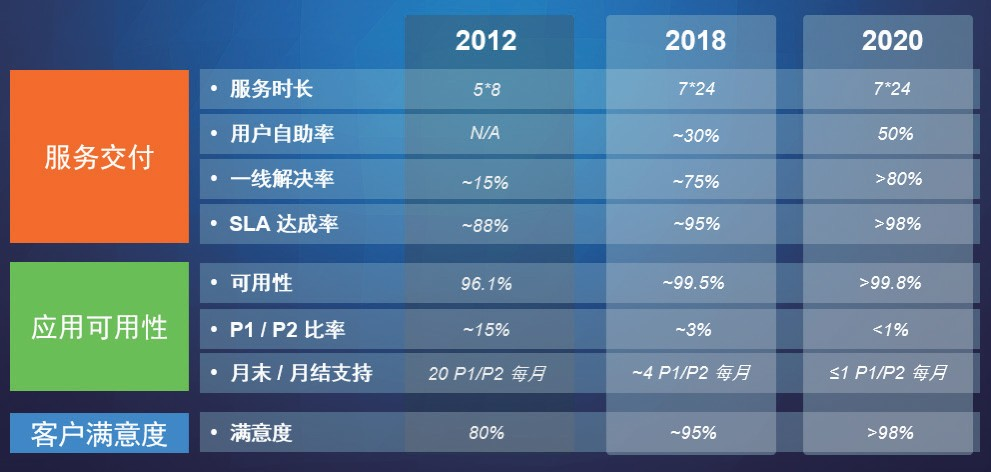
Adjustments and Recommendations
04
As a global enterprise, Lenovo’s IT operations team continuously enhances standardization, automation, and intelligence to better ensure business operations. In the process of conducting IT operations work, we introduced the ITSS standard, with service standardization being the cornerstone of the IT operations team’s service level improvement. Taking the IT service desk as an example, after undergoing standardization, the IT service desk’s manual document data has become complete, clearly categorized, and thoroughly recorded. After extensive document analysis, we found that issues related to office software consistently ranked first, which also became the first entry point for the intelligent self-service robot. On the other hand, service standardization allows for consistent measurement of each team’s services, aligning service levels and improving user satisfaction.
Today, digitalization is breaking the boundaries of traditional IT operations, and standardization has made automation and intelligence possible. By transforming standardized processes into automated or even intelligent processes, we can better and faster serve users, primarily discovering and resolving faults, allowing business departments to focus on developing their own business, while the IT operations team creates more value for the company.
Click to follow IT as a Service and reply in the background with “2022 Data Security Industry Insight Report” to download the complete 220,000-word PDF file

Platform Operations, Standing at the C Position of Industrial Digitalization

IT Service Weekly | IDC: In 2021, China’s network market size reached $10.24 billion, with a year-on-year decline of 2.6% in the router market
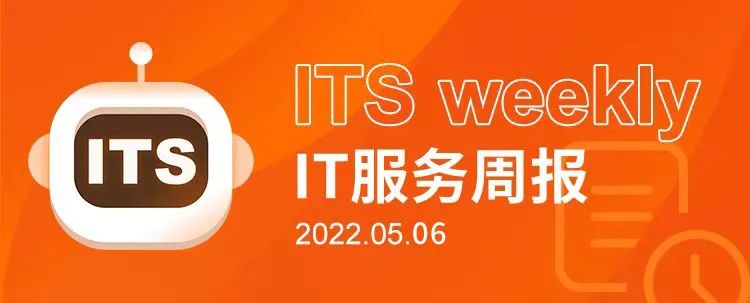
IT Service Experts Speak | Insights from Renowned Experts and Industry Leaders

Application Open | 2022 China Enterprise Market SaaS Map

2021-2022 IT Intelligent Service Rankings & Awards Announced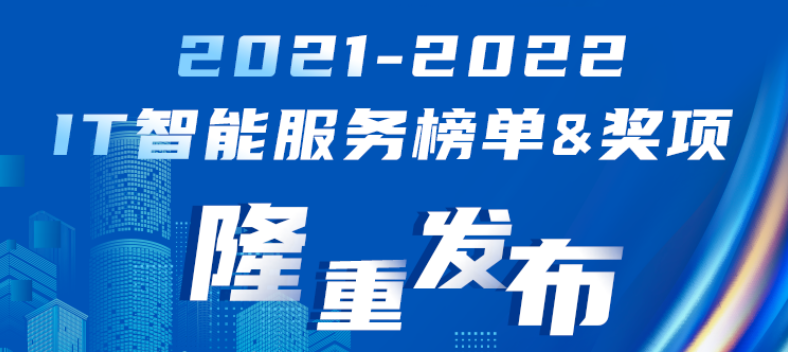 Understanding ITSS 5.0 in One Image
Understanding ITSS 5.0 in One Image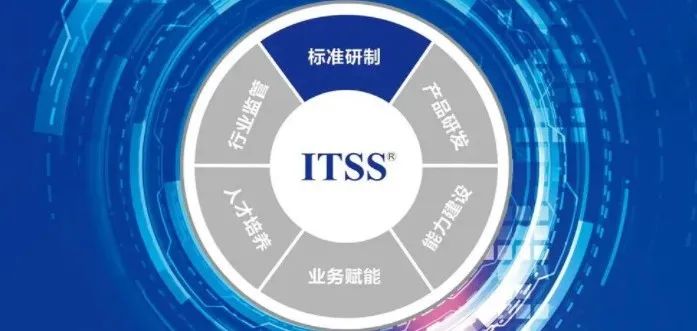 What is the Metaverse that is Being Raved About?
What is the Metaverse that is Being Raved About?
